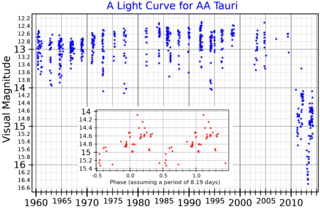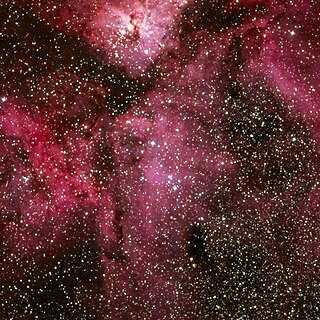
W Sagittarii is a multiple star system star in the constellation Sagittarius, and a Cepheid variable star.

10 Aquilae is a star in the equatorial constellation of Aquila. 10 Aquilae is the Flamsteed designation. It has an apparent visual magnitude of 5.9 and thus is a faint star that is just visible to the naked eye in dark skies. The brightness of this star is diminished by 0.17 in visual magnitude from extinction caused by interstellar gas and dust. Based on an annual parallax shift of 13.45 mas, the distance to this star is around 240 light-years.

RT Aurigae is a yellow supergiant variable star in the constellation Auriga, about 1,500 light years from Earth.
47 Boötis is a binary star system in the northern constellation of Boötes, located 261 light years away from the Sun. It has the Bayer designation k Boötis; 47 Boötis is the Flamsteed designation. The system is visible to the naked eye as a faint, white-hued star with a combined apparent visual magnitude of 5.58. It is moving closer to the Earth with a heliocentric radial velocity of −13 km/s.
HD 113703, also known by the Bayer designation f Centauri, is a multiple star system in the southern constellation of Centaurus. The combined apparent visual magnitude of this system is +4.71, which is sufficient to make it faintly visible to the naked eye. The distance to this system is approximately 400 light years based on parallax measurements. It is a member of the Lower Centaurus Crux subgroup of the Scorpius–Centaurus association.

Zeta Cephei is a star in the constellation of Cepheus. Zeta Cephei marks the left shoulder of Cepheus, the King of Joppa (Ethiopia). It is one of the fundamental stars of the MK spectral sequence, defined as type K1.5 Ib.
HD 97048 or CU Chamaeleontis is a Herbig Ae/Be star 603 ly away in the constellation Chamaeleon. It is a variable star embedded in a dust cloud containing a stellar nursery, and is itself surrounded by a dust disk.

AA Tauri is a young variable star in the equatorial constellation of Taurus, located in the Taurus-Auriga star-forming region. It is too faint to view with the naked eye, having an apparent visual magnitude that varies from 12.2 down to 16.1. The star is located approximately 439 light-years away from the Sun based on parallax, and is drifting further away with a radial velocity of +17 km/s.

WR 148 is a spectroscopic binary in the constellation Cygnus. The primary star is a Wolf–Rayet star and one of the most luminous stars known. The secondary has been suspected of being a stellar-mass black hole but may be a class O main sequence star.

Sigma Ophiuchi, Latinized from σ Ophiuchi, is a single, orange-hued star in the equatorial constellation Ophiuchus. Its apparent visual magnitude is 4.31, which is bright enough to be faintly visible to the naked eye. The annual parallax shift of 3.62 mas as seen from Earth provides a distance estimate of roughly 900 light years. It is moving closer to the Sun with a radial velocity of −28 km/s.

Rho Pavonis, Latinized from ρ Pavonis, is a single, variable star in the southern constellation of Pavo. It is yellow-white in hue and faintly visible to the naked eye with an apparent visual magnitude that fluctuates around 4.86. The star is located at a distance of approximately 190 light years from the Sun based on parallax, and is drifting further away with a radial velocity of +8 km/s. It is a candidate outlying member of the Tucana Association of co-moving stars.

Y Centauri or Y Cen is a semiregular variable star in the constellation of Centaurus.

S Muscae is a classical (δ) Cepheid variable star in the constellation Musca about 2,600 light years away.

9 Persei is a single variable star in the northern constellation Perseus, located around 4,300 light years away from the Sun. It has the Bayer designation i Persei; 9 Persei is the Flamsteed designation. This body is visible to the naked eye as a faint, white-hued star with an apparent visual magnitude of about 5.2. It is moving closer to the Sun with a heliocentric radial velocity of −15.2 km/s. The star is a member of the Perseus OB1 association of co-moving stars.
EQ Pegasi is a nearby binary system of two red dwarfs. Both components are flare stars, with spectral types of M4Ve and M6Ve respectively, and a current separation between the components of 5.8 arcseconds. The system is at a distance of 20.4 light-years, and is 950 million years old. The primary star is orbited by one known exoplanet.

CD Crucis, also known as HD 311884, is an eclipsing binary star system in the constellation Crux. It is around 14,000 light years away near the faint open cluster Hogg 15. The binary contains a Wolf–Rayet star and is also known as WR 47.

3 Geminorum is a blue supergiant star in the constellation Gemini. It is a small amplitude pulsating variable and a close double star, with a mean combined apparent visual magnitude of about 5.7.
WR 135 is a variable Wolf-Rayet star located around 6,000 light years away from Earth in the constellation of Cygnus, surrounded by a faint bubble nebula blown by the intense radiation and fast wind from the star. It is just over four times the radius of the sun, but due to a temperature of 63,000 K it is 250,000 times as luminous as the sun.

Collinder 228 is an open cluster within the southern part of the Carina Nebula NGC 3372, about 25' south of η Carinae. It is probably composed of stars which recently formed from the material in the nebula. QZ Carinae is the brightest member of Collinder 228 with an apparent magnitude between 6.16 and 6.49.

HD 150193 is a binary star system in the constellation of Ophiuchus. The primary star was identified as a Herbig Ae/Be star with a strong solar wind, losing approximately a tenth of solar mass per million years. It does host a very small debris disk, likely due to disk truncation by the nearby stellar companion. The disk is inclined 38±9° to the plane of sky. It appears to be highly evolved and asymmetric, with indications of flattening and grains growth.















